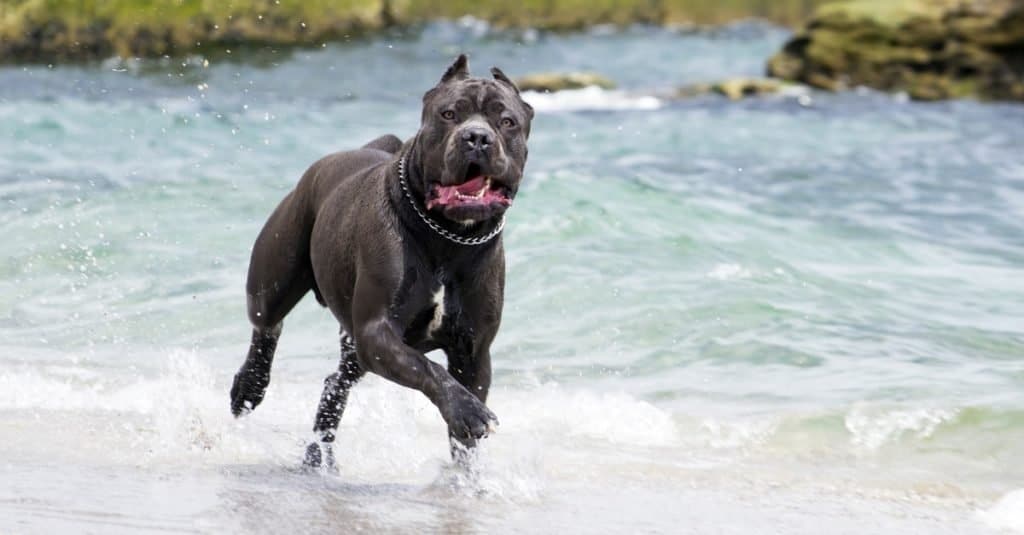The Cane Corso is a large dog breed. This Italian breed was developed to serve as a guard dog, and it is included in the broader class of molossus dogs. It is a descendant of the war dogs raised in ancient Rome and is typically kept as a companion or security dog. It has also been used to herd livestock and hunt enormous animals. Molossi, who was thought to have bred large dogs resembling Mastiffs in Greece, is where Mollosers get their name. Cane Corso canines are frequently referred to as Italian Mastiffs as a result.
The Cane Corso breed’s ancestors were probably significantly bigger than the canines we see now. They were employed in combat and aided the army’s assault on the enemy’s lines. The mid-1900s saw this dog breed on the edge of extinction. Although they were saved, they did not become known worldwide until the late 20th century. Because of how big these dogs are, it is no surprise that many people are interested in discovering more about them. Keep reading to learn more about Cani Corsi, particularly their teeth, their types, and how they use them.
How To Identify the Cane Corso

xkunclova/Shutterstock.com
The Cane Corso is a big dog related to the Neapolitan Mastiff. Males typically weigh between 99 and 110 pounds and are between 24 and 28 inches tall, depending on the gender. Females usually weigh between 88 and 99 pounds and are slightly smaller at 23 to 26 inches. Puppy weight at one month of age is less than nine pounds.
These dogs are included in the broader group of molossus dogs. Cani Corsi usually have massive heads with somewhat converging skulls and muzzles that are not parallel to one another. The dog’s head has firm, silky skin, and the skull appears square, comprehensive, and slightly bent when viewed from the top of the dog. Generally, the Cane Corso appears to be strong, athletic, and muscular. They also move with a fluid gait that is effortless and has significant reach.
Cane Corso Milk Teeth

Sbolotova/Shutterstock.com
Like most dogs and other mammals, Cani Corsi give birth to their pups alive, and these pups are born without teeth. In a mammal-like fashion, these dogs feed their babies milk for the first few weeks after their birth. After three to four weeks of living off their mother’s milk, Cane Corso puppies start to grow milk teeth, otherwise called deciduous teeth. Like most puppies, when the milk teeth of a Cane Corso start to grow, it can cause a lot of discomfort and pain for the puppy. During this period, they tend to chew on a lot more things than usual in a bid to scratch their itchy gums.
There is no specific number that will grow at once at the start of this stage of their milk teeth’s development. Unlike most dogs that grow all their milk teeth after eight weeks, Cane Corso puppies have a complete set of milk teeth after about five weeks. Cane Corso puppies have 28 milk teeth. Like other puppies, Cane Corso puppies only have their milk teeth in for a few months. However, for a variety of reasons, the average age at which they all lose their baby teeth differs. Some only keep their milk teeth for three months, while others keep them for as long as four and a half.
Adult Cane Corso Teeth

Sbolotova/Shutterstock.com
One of the biggest changes in a Cane Corso puppy’s development is the emergence of adult teeth. Adults have 42 permanent teeth, as opposed to puppies’ 28 milk teeth. The discomfort your Cane Corso puppy feels increases when they begin to lose their milk teeth to give way to their adult teeth. At this point, it is not uncommon to find subtle blood stains from them scratching their gum vigorously. It is also at this point that your puppy needs the most love and attention.
Because they do not realize how sharp their teeth are during this period, it is advisable not to put your hands too close to your Cane Corso puppy’s mouth; you also should not brush their teeth during this period because of how sensitive their gums would be. Around three months of age is when the Cane Corso will begin to experience teething. But some puppies might begin sooner and others a little later. Their background and genetics are just two of the many variables that affect this.
This teething will continue until they have their complete 42 adult teeth, which is usually around the time they turn eight or nine months old. At this point, the discomfort and teething should stop altogether. Once it does, it is advisable to get your puppy’s teeth checked out at a vet’s. The reason for this is to make sure that their oral health is in check, and that there were no complications such as a “double tooth” while the adult teeth were growing. A double tooth develops when some milk teeth do not entirely fall out to make room for adult teeth and the two just continue to grow together.
What Type of Teeth Do Cani Corsi Have?
As expected, Cane Corso dogs have very sharp teeth. Like other dog breeds, they have different teeth for different reasons- premolars, molars, incisors, and canines.
Incisors
Cani Corsi have a total of 12 incisors- six on each row. On both rows, the incisors closer to their canines are bigger than the others. However, the biggest ones on the top row overlap the canines. These dogs use their incisors to hold on to their food and other things.
Canines
Like all dogs and carnivorous animals, the canines of Cani Corsi have adapted to fit their dietary lifestyle. These dogs have a total of four canines, two on each row. Their canines are inclined outward, making them appear much sharper than they are, and there is hardly any space between them and their incisors. Cane Corsos use their canines to tear food and even puncture through flesh.
Carnassials
The premolars and molars are together referred to as the carnassials. The Cane Corso has eight premolars on both their top and bottom jaws, and six molars on their upper jaw but only four on the bottom. These dogs use their premolars in chewing and shredding food, while they use their molars to crush their food into smaller bits to make it easier for them to swallow.
Dental Problems Associated With Cane Corso Dogs
There are no specific dental problems that affect Cane Corso dogs, apart from the ones caused by poor oral hygiene. Despite the fact that dogs, like some people, are simply more prone to plaque buildup, this is frequently caused by the human parents’ failure to practice regular tooth brushing than anything else.
Despite being muscular and strong, Cani Corsi are still vulnerable to diseases, and their dental health is not an exception. They particularly suffer from periodontal disease. Bacteria that originate in the gums can enter the bloodstream and impact the lungs, the kidneys, and even the heart in addition to inflammation, foul breath, and tooth loss. When the first indications of calcified material show up—the teeth have a yellowish tint—you should brush the dog’s teeth with a small tooth stick coated in some unscented toothpaste.
After brushing, the Cane Corso’s teeth should be cleaned with a moist cotton-gauze pad and then gently dried with a dry piece of cloth. Lack of routine oral hygiene for dogs results in the development of dental calculus, which negatively impacts the health of the enamel on the teeth. The easiest way to prevent your dog’s oral health from deteriorating is to practice proper oral hygiene. In addition, ensure your dog gets frequent check-ups from a professional just to be sure everything is good.
Up Next:
10 Incredible Cane Corso Facts
The Best Dog Food for Cane Corso for 2022
Cane Corso Vs. Great Dane: What are the 8 Key Differences?
The post Cane Corso Teeth: Everything You Need To Know appeared first on AZ Animals.
from Animal News, Facts, Rankings, and More! - AZ Animals https://ift.tt/PsSdZRa